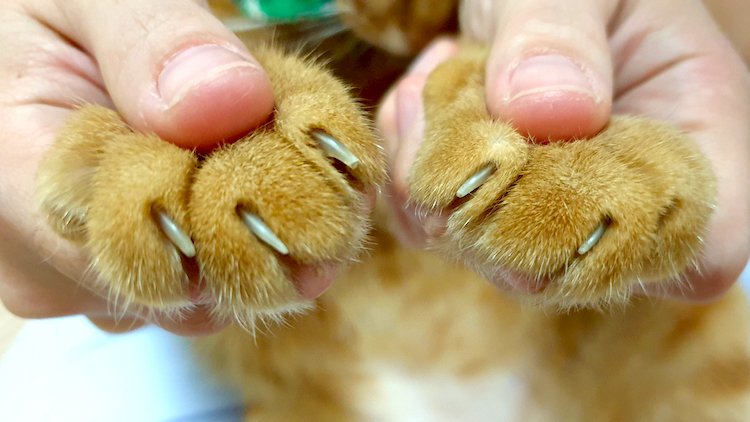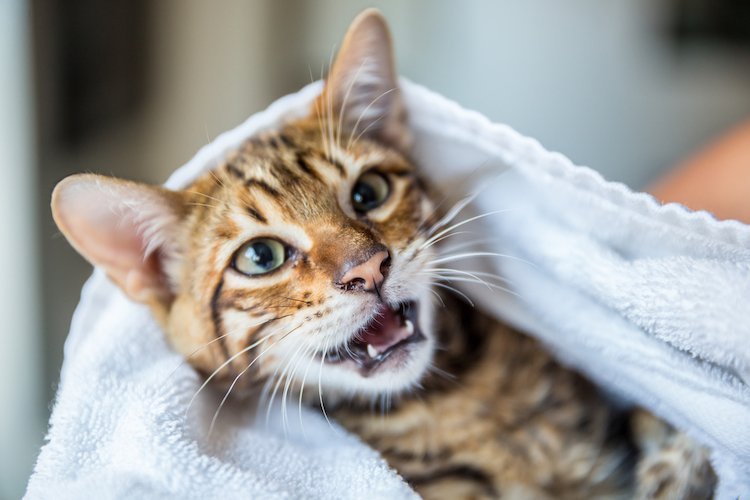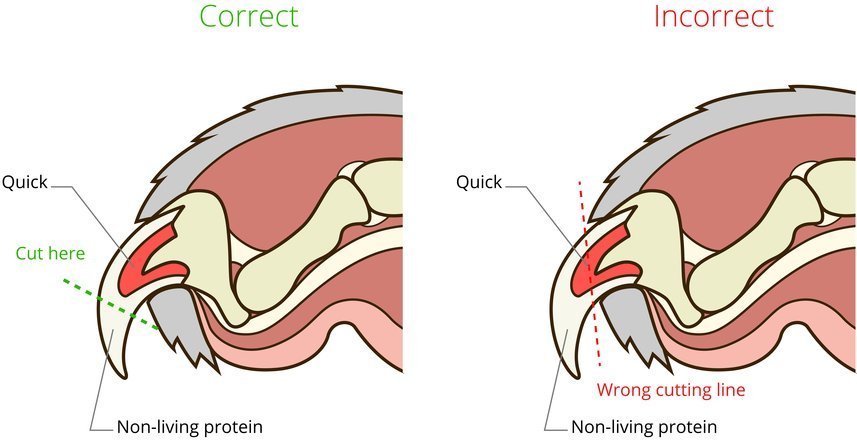How to Cut Cat Nails With Human Clippers

Trimming a cat's nails? It can be a do-it-yourself affair — but not always.
Cats' personalities vary widely, and some cats will never easily submit to their claws being touched, manipulated and clipped by humans.
Please bear that in mind as you read on.
Do All Cats Need Nail Trims?
- Indoor cats should have their nails inspected occasionally to make sure they are healthy and trimmed as necessary.
- Outdoor cats usually take care of their own nail trimming and should have natural claws for climbing and defense purposes.
Scratching posts and "non-approved" scratching surfaces help to keep an indoor cat's nails in shape, but most indoor cats have quite sharp nails.
So, how often should you trim your cat's nails?
- While many people never trim their cat's nails, those who want a duller nail without that incredibly sharp hook at the end need to trim nails every 6–8 weeks.
- Arthritic or older cats should have their cats inspected every 2 months and trimmed if necessary.
To get started, you will need:
- A reasonably willing cat.
- Nail trimmers of your choice.
- A restraint plan.
- A calm human helper might be a great asset.

How to Get Your Cat Used to Nail Trims
It's never too early to start trimming cat nails or getting your cat accustomed to having their paws touched.
It might actually be a little late if you have an older cat who has never had their nails trimmed and will never understand why you want to start now.
- Begin by touching the cat's feet. Do this well before you reach for the nail clippers.
- Massage your cat's feet, but don't get into any kind of rough play. We don't want to promote the idea of your cat clawing at you or trying to grab your hand with their claws. If they think this is play time, wait until they're tired or resting to see if they'll let you casually pick up a paw and rub it.
- See if you can gently press on a toe to make the nail protrude. Cats have retractable claws. There is a skill involved in gently pressing on the digit to expose the toe. More on this technique later.
What Kind of Nail Trimmers Should You Use on Your Cat?
You can choose from among several kinds of pet nail trimmers and human nail clippers. Five options appear below.
Personally, I prefer human nail clippers for cat nails. They are less cumbersome and give you a good visual of where you are cutting.

1. Scissor-Type Trimmers
These nail trimmers look like a pair of scissors made specifically to cut nails on small animals. You might find these easy to use.
Quality matters, however, and the cheap ones can be dull and not give you a nice cut.

2. Nail Clippers for Dogs and Cats
Professional nail clippers like your veterinarian uses on your dog and possibly your cat are a good investment.
Check out Millers Forge, for example. These strong clippers will usually last a lifetime, and they have user-friendly handles, surgical steel blades and a safety lock.
Some people find these too big for cat nails, but I like them.
They come in various sizes. Again, quality matters.

3. Guillotine-Style Clippers
This type of clipper is also considered professional grade, but I don't think the guillotine design is as easy to use as some other devices are. I think it is easier to hurt your cat with these.
Getting the nail perfectly set into the little guillotine window requires time and skill. The guillotine must be perpendicular to the nail. The extra few seconds required to get the proper nail placement may make you lose your golden window of opportunity.

4. Human Nail Clippers
Many people find human nail clippers, a staple in every household, the easiest tool to cut your cat's nails — and I agree. They are small, so you are close to your cat's nail and can quickly trim a nail.
These work best turned sideways to cut the cat nail, the opposite of how you cut your own nails.

5. Dremel
Beware the advertising on all the Dremel tools sold online and in stores. They make it look so easy, but that is not the case.
These Dremels make a noise, create a vibration sensation and can take a while to sand down the nail. Most cats are not fond of a noisy, vibrating tool coming at them.

How to Restrain Your Cat for Nail Trimmings
Some cats require very little restraint, but here are some tips for the fearful, fretful or ferocious feline.
Little or No Restraint
If you have a fairly willing cat, they may find comfort lying in your lap.
Gently rest or drape your forearm over the cat's neck and hindquarters and try to pick up a foot, usually with your left hand and clippers in the right hand.
You might want to have a thick towel or pillow on your lap between you and the cat in case your cat decides to use your thighs as a springboard to leap off your lap.
Let's say this doesn't go so well: My suggestion is to wait and try again at another time when your cat is calm and is not aware of what you're up to.
The Towel Method
Some cats are not necessarily nasty but are just jumpy and wriggly.
- First, wrap them in a bath towel.
- Then try to take out a paw for nail trimming.
With some practice, the towel can help envelop 3 limbs while you take out 1 limb at a time.
The 2-Person Method
If you have ever watched your vet and a vet tech trim your cat's nails, 2 people can often make this task go quite smoothly.
A table or countertop works well. One person holds or even restrains with a back-of-the-neck grip while the other person trims the nails.
This is not for every couple or roommate team — nor is it for every cat. You can get hurt if you aren't comfortable with your partner or with restraint.
If you are failing to trim your cat's nails comfortably at this point, screaming at your husband or bleeding, you either need to ask for a tutorial from your vet's office or give up and leave it to the professionals.

The Actual Nail Trim
Cats have 4 nails plus 1 dewclaw on the front feet, and 4 nails on the rear feet.
(Some cats have "extra toes," and some of these need trimming or they will grow into the cat's foot. For more on this, see my article "Polydactyl Cats: Extra Toes Can Cause Extra Problems.")
Cat claws are retractable or retractile. You need to gently put pressure on the toe between your thumb and forefinger to expose the claw and then trim it.
Most cats, unlike many dogs, have light-colored claws, making trimming easier.
Your purpose is to trim the pointy, sharp end of the claw only. The closer you come to the pink part of the nail — called the quick — the more likely you are to get an extremely negative response from your cat. If you cut into the quick, you get bleeding, which really does hurt the cat.
Trim the most offending nails first, usually the front feet. Don't forget the dewclaw on the inner aspect of the foot.
Many cats do not do much damage with their back feet and may not need these trimmed frequently or at all.
How to Stop Bleeding
Nails trimmed too short usually stop bleeding on their own in a few minutes.
If your cat has run away from you and is hiding under your bed, my advice is to leave them alone. They are not going to lose significant blood. You can inspect the nail when your cat stops being furious at you and comes out on their own.
There are products sold to stop bleeding like Kwik Stop, a styptic powder, or styptic pencils containing silver nitrate. Applying a clotting agent, however, requires even more restraint.
The cat may be angry at this point, and the nail may hurt a bit. Stopping bleeding is not always advisable.
Long story short, make sure you don't cut close to the quick.
Here's a step-by-step video showing how to trim cat nails:
Ask Your Veterinarian for Help
Many people can learn a lot from a quick tutorial at your vet's office.
Call ahead and see if you can meet with a vet tech for a nail clip session, or remember to include it in your annual exam.
The veterinary environment, however, is different from the home, so how your cat behaves at the vet may not be what happens in your living room.
Some cats are more docile because they are frightened at the vet's office, while others are more angry. Vets don't want to intensify fear in your cat at the veterinary visit, so nail clipping may not always be advised if this is the one event that is going to send your cat over the edge.
Cat nail clipping at home requires a well-adjusted patient and a patient pet parent.
References
[accordion tag=p clicktoclose="true"]
[accordion-item title="+ Click to see the sources for this article."]
- "Clipping a Cat's Claws." Washington State University College of Veterinary Medicine. https://www.vetmed.wsu.edu/outreach/Pet-Health-Topics/categories/procedures/cats/clipping-your-cat%27s-claws.
- "Cat Grooming Tips." American Society for the Prevention of Cruelty to Animals. https://www.aspca.org/pet-care/cat-care/cat-grooming-tips.
- "Trimming a Cat's Claws." The Humane Society of the United States. https://www.humanesociety.org/resources/trimming-cats-claws.
[/accordion-item][/accordion]
 This article was written by a veterinarian, Dr. Debora Lichtenberg, VMD. It was last reviewed April 2, 2019.
This article was written by a veterinarian, Dr. Debora Lichtenberg, VMD. It was last reviewed April 2, 2019.
If you have questions or concerns, call your vet, who is best equipped to ensure the health and well-being of your pet. This article is for informational purposes only and is not a substitute for professional medical advice, diagnosis or treatment. See additional information.
How to Cut Cat Nails With Human Clippers
Source: https://www.petful.com/grooming/how-trim-cats-nails/